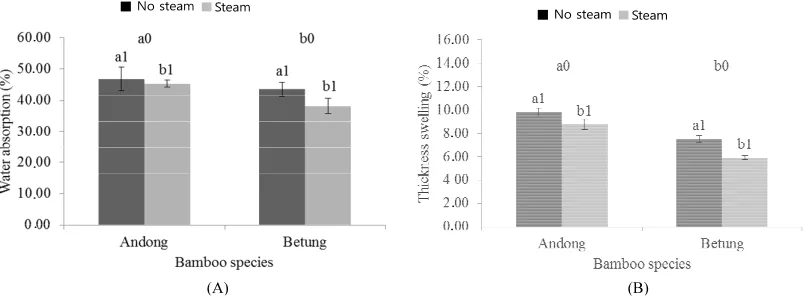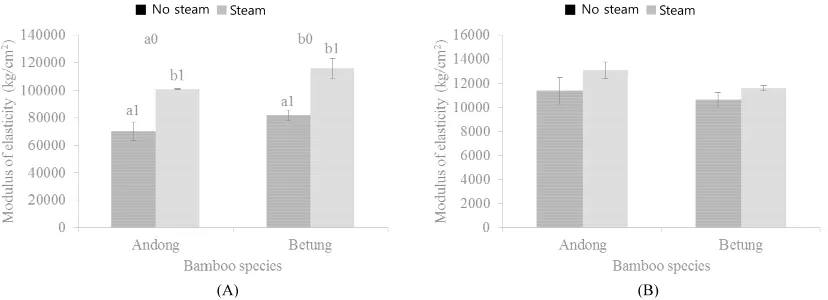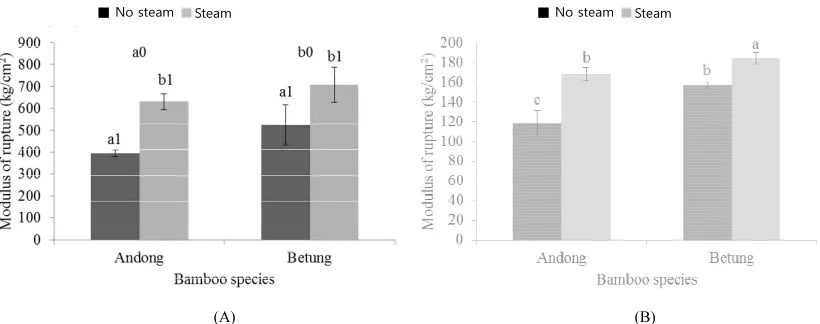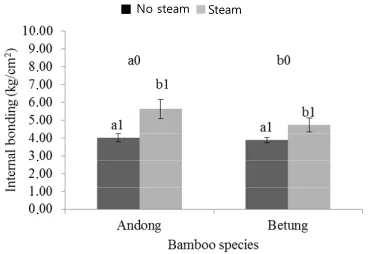1. INTRODUCTION
Bamboo resources in Indonesia is abundant
and have a big potential for new products
developement. Bamboo plantation in Indonesia in 2000 was 2,104,000 ha, consisted of 690,000
ha in permanent forest and 1,414,000 ha in
non-forest areas (FAO and INBAR, 2005).
Original Article
Effects of Steam Treatment on Physical and
Mechanical Properties of Bamboo Oriented Strand Board
1Sena Maulana2⋅Imam Busyra2⋅Adesna Fatrawana2⋅Wahyu Hidayat3⋅Rita Kartika Sari2⋅
Ihak Sumardi4⋅I Nyoman Jaya Wistara2⋅Seung Hwan Lee5⋅Nam Hun Kim 5,†⋅Fauzi Febrianto 2,†
ABSTRACT
The objective of this study was to evaluate the properties of bamboo oriented strand board (B-OSB) from an-dong (Gigantochloa psedoarundinacea) and betung (Dendrocalamus asper) with and without steam treatment. Strands were steam-treated at 126℃ for 1 h under 0.14 MPa pressure. The extractive content of bamboo strands before and after steam treatment were determined according to a standard (TAPPI T 204 om-88). Three-layer B-OSB with the core layer perpendicular to the surface and back layers were formed and binded with 8% of phenol formaldehyde (PF) resin with the addition of 1% of wax. The evaluation of physical and mechanical properties of the boards were conducted in accordance with the JIS A 5908:2003 standard. The results showed that steam treatment of bamboo strands significantly reduced the extractive content. Steam treatment tended to increase the dimensional stability and mechanical properties of B-OSB from andong and betung. The results showed that the dimensional stability and bending strength of B-OSB from betung was higher than those of andong. The internal bond strength of B-OSB from andong was higher than betung owing to a greater amount of extractives dissolved during the steam treatment.
Keywords : bamboo, Dendrocalamus asper, Gigantochloa psedoarundinacea, oriented strand board, steam treatment
1Date Received October 16, 2017, Date Accepted November 16, 2017
2Department of Forest Products, Faculty of Forestry, Bogor Agricultural University, IPB Dramaga Campus, Bogor, 16680, Indonesia
3Department of Forestry, Faculty of Agriculture, University of Lampung, Jalan Sumantri Brojonegoro 1, Bandar Lampung 35145, Indonesia
4School of Life Sciences and Technology, Institut Teknologi Bandung, Jalan Ganesha 10 Bandung 40132, Indonesia 5Department of Forest Biomaterials Engineering, College of Forest and Environmental Science, Kangwon National University,
Chuncheon 24341, Republic of Korea
†Corresponding author: Author:Fauzi Febrianto(e-mail: [email protected], ORCID: 0000-0002-0964-2179) †
Widjaya (2012) reported that there were 160
bamboo species consisted of 122 endemic
spe-cies and 38 exotic spespe-cies. Compared to wood,
bamboo has fast growth rate, abundant potency, short cycle, and adaptable to most of soil types
except soil in the beach area. In addition, the
tensile strength of bamboo is comparable to wood. Due to its advantages, bamboo has been
used as raw materials for industry, construction,
furniture, household equipment, and handicrafts. However, bamboo also has some limitations
when they are used for construction material,
particularly due to its diameter. The small
di-ameter and thin culm of bamboo made the solid bamboo difficult to be used for panel products
that generally needed a long and wide
dimensions. In addition, bamboo also has low modulus of rupture and high variability of
physical properties, particularly the density in
the bottom, middle, and upper parts.
Composite products can be used as
alter-natives to increase the efficient utilization of
bamboo for structural and non-structural
applications. Oriented strand board (OSB) is one of the structural composite panels that has
been used as a substitution for plywood
products. Structural Board Association (2005) defined OSB as structural composite panel
made from long and thin strand with the core
layer alligned perpendicularly to the back and
surface layers and compacted using hot pressing. Our previous studies revealed that the
physical and mechanical properties of bamboo
OSB (B-OSB) were higher than those of OSB from wood, and met the standard requirement
for commercial OSB (Febrianto and Hadi,
2010; Febrianto and Arinana, 2012; Febrianto et
al., 2012; Adrin et al., 2013; Febrianto et al.,
2013; Febrianto et al., 2014).
The properties of particleboard and OSB are
affected by wood species, density, strand
di-mensions, strand pre-treatment, particle entation, resin type and content, layer
ori-entation, pressing parameters, moisture content
and board density, and density profile of the
board (Maloney, 1993). The extractive content of bamboo, particularly the carbohydrates and
sugars content is relatively higher than wood
(Fatriasari and Hermiati, 2008; Zhang, 1995). Carbohydrates and sugars are food sources for
wood-damaging agents such as wood-decaying
fungi, moulds, wood-destroying insects or ma-rine borers which make bamboo susceptible to
be attacked by such damaging agents (Febrianto
et al., 2013). Pretreatment on strands can be
applied to solve the problem, such as steam treatment.
Conventionally, steam treatment is generally
applied for solid bamboo during the production of bending products to soften its tissues, hence
bamboo becomes easier to be bended into
de-sired form. Steam treatment could improve the
durability of bamboo againts degrading agents (Liese, 1987). During steam process, free sugars
in lignocellulosic materials is converted into
in-termediate furane and furane resin to improve
the board properties (Rowell et al., 2002).
Steam treatment of strands has been reported to
our previous study, we reported the properties
of B-OSB from steam-treated bamboostrand
binded with isocyanate resin (Febrianto et al.,
2015). However, the effects of strand steam treatment on the properties of B-OSB binded
with formaldehyde-based resin has not been
reported. Therefore, the objective of this study is to evaluate the properties of B-OSB with and
without steam treatment, using PF resins as
adhesives.
2. MATERIALS and METHODS
2.1. Materials
Two bamboo species, i.e. andong
(Gigantochloa psedoarundinacea) and Betung (Dendrocalamus asper) were obtained from
3-year-old bamboo plantation in Sukabumi,
West Java, Indonesia. PF resin was used as a binder. Chemical reagents were used for the
de-termination of differeent extractive contens.
Main equipments used in this study are band saw, circular saw, planer, disk flaker, kiln
dry-ing furnace, shieve, water bath, oven drier,
digi-tal weight scale, moisture meter, glue blending
drum, spray gun, strand orienter, forming de-vice, caliper, hot press, and universal testing
machine (UTM) instron.
2.2. Methods
2.2.1. Strand Preparation and B-OSB
Manufacture
Bamboo culms without internodes were
con-verted into strands using disk flaker. The
strands were treated with steam at 126℃ for 1
h under a pressure of 0.14 MPpa. Strands were
air dried for a week then oven dried at 60-80℃
for 3 days until reaching moisture content of less than 5%. Three-layer B-OSBs were made
with the dimension of 30 × 30 × 0.9 cm3
(length × width × thickness) using a face-to-core layer ratio of 1 : 1 : 1 (→ change this to a face
to core rartio such as 60 : 40, 55 : 45). The
tar-get board density was 0.7 g/cm3. PF resin was
used as a binder with the solid content of 42%
and resin content of 8%. An addition of 1%
wax was used. The strands were then hot
press-ed at 135℃ under a pressure of 25 kgf/cm2.
The resulted B-OSBs were conditioned for two
weeks under room temperature (25-30℃) until
reaching a constant weight.
2.2.2. Strand Geometry Measurement
Strand geometry was measured using 100
strands that obtained randomly. Dimensions of
strands such as length, width, and thickness were measured. The slenderness ratio (SR) and
aspect ratio (AR) of the strands were
de-termined according to the method described by Maloney (1993).
2.2.3. Extractive Isolation
The extractive content of bamboo strands
be-fore and after steam treatment was analyzed in accordance with TAPPI standards. Samples
were extracted using alcohol-benzene solvent
2.2.4. Physical and Mechanical Properties
Evaluation
The physical and mechanical properties of
B-OSB were evaluated according to the
proce-dure of JIS A 5908-2003 (JIS 2003) for
particleboards. The physical properties evaluated were density, moisture content (MC), water
ab-sorption (WA), and thickness swelling (TS),
while mechanical properties evaluated were modulus of rupture (MOR), modulus of
elas-ticity (MOE), and internal bond (IB) strength.
3. RESULTS and DISCUSSION
3.1. Geometry of Bamboo Strands
Strand geometry is a prime parameter
affect-ing both board properties and its manufacturaffect-ing process. Suchsland and Woodson (1990)
sug-gested that strand geometry is of greater
sig-nificance in the development of board proper-ties than the actual mechanical properproper-ties of the
strands themselves. It has a definite relationship
with the compression ratio, and thus it will in-fluence the density of composite board. The
strands manufactured have satisfactory
geome-try, showing high values of slenderness ratio
(SR) and aspect rato (AR) as shown in Fig. 1. The average SR of strands from andong and
betung were higher than 100 and classified as
high SR (Febrianto et al., 2015). Strands with
high values of SR affected on a better contact
between strands and improved strength
proper-ties of the boards (Maloney, 1993). The average AR of strands from andong and betung were
greater than 3. Maloney (1993) stated that wood strand having aspect ratio greater than
one are easily oriented during forming process.
According to Shuler et al. (1976) and
Kuklewski et al. (1985), strand aspect ratio of
two is enough to produce OSB with superior
properties.
3.2. Extractive content
The results of extractive analysis showed that
the extractive content of andong and betung de-creased by steam treatment (Table 1). Steam
treatment caused the loosening and softening of
cell walls, resulted in the reduction of
ex-tractive content. Donohoe (2008) stated that during steam process, the heat and pressure
ap-plied increased the porosity of cell walls
(Donohoe, 2008). Miranda et al. (1978) added
that steam could cause depolymeration and
repolymeration of lignin. This caused the
extraction of extractive decreased in the
bamboo strands.
3.3. Physical properties of B-OSB
The density of particleboard is affected by the density of the raw materials, which makes a
contribution to the physical and mechanical
propeties of the board (Tsoumis, 1991). The
densities of the manufactured B-OSBs were
ranging between 0.70-0.73 g/cm3
and 0.71-0.72
g/cm3 for andong and betung, respectively. The
results of analysis of variance (ANOVA) at a significance level of 0.05 showed no significant
strand treatment.
The moisture content (MC) values of B-OSBs from andong were ranging between 9.38% and
10.38%, while betung between 9.38% and
10.33%. B-OSBs of both bamboo species were
relatively homogeneous, showing no significant
differences in the MC values between species
and strand treatment.
Water absorption (WA) and thickness
swel-ling (TS) are of the important parameters to
evaluate the dimensional stability of composite
panels. WA shows the ability of board to
ab-(A)
(A)
.
.
. .
.
.
.
.
.
(A) (A)
(B)
(B)
.
.
. .
.
. . . .
(B) (B)
Fig. 1. Aspect ratio and slenderness ratio of the strands from andong (A) and betung (B) bamboo.
Bamboo species Extractive type Strand treatment
Control Steam
Water-soluble (%) 4.29 3.95
Hot water-soluble (%) 5.81 5.64
Andong 1% NaOH soluble (%) 22.57 19.29
Ethanol-benzene-soluble (%) 3.20 3.11
Betung
Water-soluble (%) 5.63 4.62
Hot water-soluble (%) 7.64 6.45
1% NaOH soluble (%) 19.43 18.51
Ethanol-benzene-soluble (%) 9.09 8.89
sorp water due to adsoption force, which is the
captive force of water molecules in the
hydro-gen bonds located in cellulose, hemicellulose and lignin. WA values after 24 h of water
im-mersion were ranging between 45.35-46.82%
and 38.18-43.56% for B-OSBs from andong and betung, respectively (Fig. 2a). The results
of ANOVA revealed that bamboo species and
strand treatment contributed significant effects on the WA property, while the interaction
be-tween species and strand treatment showed no
significant effect. TS values after 24 h of water
immersion were ranging between 8.77-9.82% and 5.91-7.50% for B-OSBs from andong and
betung, respectively (Fig. 2b). The results of
ANOVA revealed that bamboo species and strand treatment contributed significant effects
on TS values, while the interaction between
species and strand treatment showed no sig-nificant effect.
Steam treatment of strands reduced the WA
and TS of the B-OSBs from andong and betung. It was believed that the removal of
ex-tractives in bamboo due to steam treatment
im-proved the penetration of resin into the strand.
The improved bondability of strands resulted in a decrease in the WA of B-OSBs. B-OSBs from
betung had lower WA and TS values compared
to those of andong due to distinctive anatomical structures between these two species. Andong
has vascular bundle type III, while betung has
vascular bundle type IV with a relatively higher content of holocellulose and lignin (Liese,
1998). Lignin in the structure of wood and
other lignocellulosic materials acts as a
thermo-plastic binder that can enhance the bond
between fibers, and improves the dimensional
stability of composite panels. In addition, the
extractive contents in andong and betung might also be ascribed to the hygroscopic behaviour of
the B-OSBs.
3.4. Mechanical Properties of B-OSB from Andong and Betung
MOE shows the ability of a material to
main-■ No steam Steam
■ No steam Steam
Fig. 2. Water absorption (A) and thickness swelling (B) of B-OSBs from andong and betung with and without
tain its original form during loading. MOE
val-ues parallel to the grain direction of B-OSBs
were ranging between 70131-100965 kg/cm2
and
81831-115610 kg/cm2 for andong and betung,
respectively (Fig. 3a). By contrast, the MOE
values perpendicular to the grain direction of B-OSBs were ranging between 11407-13097
kg/cm2 and 10662-11625 kg/cm2 for andong
and betung, respectively (Fig. 3b). The results of ANOVA showed that bamboo species and
strand treatment had significant effects to MOE
values in both parallel and perpendicular direc-tion, while the interaction between species and
strand treatment was insignificant.
MOR shows the maximum load that can withstand by a materials. MOR values parallel
to the grain of B-OSBs were ranging between
394-696 kg/cm2 and 524-763 kg/cm2 for andong
and betung, respectively (Fig. 4a). The results
from ANOVA showed that bamboo species and
strand treatment contributed significant effects
on MOR values parallel to the grain direction.
MOR values perpendicular to the grain of
B-OSBs were ranging between 119-211 kg/cm2
and 157-242 kg/cm2 (Fig. 4b). The ANOVA
re-sults showed that the interaction between
spe-cies and strand treatment had significant ef-fects on MOR values perpendicular to the grain
direction. The results revealed that bamboo
spe-cies and strand treatment affected the bending strength of B-OSBs including MOE and MOR.
Steam treatment decreased the extractive
con-tent of andong and betung (Table 1), resulting in a better strand adhession. Maloney (1993)
explained that extractives could interrupt the
penetration of adhessive into materials, causing
a decrease of mechanical properties.
Steam treatment of strands improved the
bending strength parallel and perpendicular to the grain of B-OSBs from andong and betung.
B-OSBs from betung strands showed better
bending strength compared to andong due to
■ No steam Steam ■ No steam Steam
(A)
(B)
(A) (B)
Fig. 3. MOE parallel (A) and MOE perpendicular (B) to the grain of B-OSBs from andong and betung bamboo
the differences in anatomical structure and the initial density of the bamboos. As described
earlier in this paper, andong has vascular
bun-dle type III, while betung has vascular bunbun-dle type IV. Latif et al. (1990) and Nuryatin (2012)
reported that vascular bundle attributed to the
values of MOE and MOR. The initial density
of andong and betung were 0.72 g/cm3 and
0.66 g/cm3
, respectively. With the target B-OSB
density of 0.7 g/cm3, the compression ratio of
B-OSB from betung was significantly higher than that of B-OSB from andong, resulting in a
better bending strength values. The results were
in a good agreement with those of Sumardi et
al. (2006) that evaluated the relationship
be-tween compression ratio and bending strength
of OSB from moso (Phyllostachys pubescens)
bamboo.
IB strength, or the tensile strength
perpendic-ular to the plane of the panel is one of the
im-portant strength properties of composite panels.
The IB strength values were ranging between
4.01-5.62 kg/cm2
and 3.89-4.73 kg/cm2
for
B-OSBs from andong and betung, respectively
(Fig. 5). The results of ANOVA showed that
bamboo species and strand treatment had
significant effects on the IB strength values of
B-OSBs. Steam treatment of the strands
improved the IB values of B-OSBs from
andong and betung. Steam treatment could
con-vert free sugars in woody materials into furan
intermediates, which can be further converted into furan resins, causing an improvement of
mechanical properties and the dimensional
stabilization of boards (Rowell et al., 2002). According to Maloney (1993), the extractive
in woody materials can cause a problem during
particleboard production due to its negative
ef-fect on the penetration of adhessive into particles. Steam treatment effectively reduced
the extractive content of andong and betung,
re-sulting in a better penetration of adhesive into
■ No steam Steam ■ No steam Steam
(A)
(B)
(A) (B)
Fig. 4. MOR parallel to the grain (a) and MOR perpendicular to the grain (B) of B-OSBs from andong and
strands and an improvement of strength
proper-ties of B-OSBs. The increase of IB values of B-OSB from andong with steam was relatively
higher than that of B-OSB from betung. This
might be due to more extractive dissolved from andong compared to betung. Table 1 shows that
NaOH-soluble extractive of andong decreased
more significantly compared to betung.
4. CONCLUSION
The geometry of strands produced from
an-dong and betung bamboo were satisfactory, showing high slenderness and aspect ratio.
Steam treatment of strands significantly reduced
the extractive content, and thus improved the dimensional stability and mechanical properties
of B-OSBs from andong and betung strands
with superior properties of B-OSBs after the
treatment than those of B-OSBs without the treatment. A simple and relatively low-cost
steam treatment of strands offers a promising
alternative treatment to produce B-OSB with
high dimensional stability and mechanical properties.
ACKNOWLEDGEMENT
We sincerely acknowledge the Doctoral Programme
for Outstanding Undergraduate Students Secretariat
(No.330/SP2H/LT/DRPM/IX/2016, 8 September 2016),
Directorate of Higher Education (DIKTI), Ministry of
Research, Technology, and Higher Education, Republic
of Indonesia due to the financial support given.
REFERENCES
Adrin, Febrianto, F., Sadiyo, S. 2013. Properties of
oriented strand board prepared from steam
treat-ed bamboo strands under various adhesive
combinations. Jurnal Ilmu dan Teknologi Kayu
Tropis 11(2): 109∼119.
Donohoe, B.S., Decker, S.R., Tucker, M.P., Himmel,
M.E., Vinzant, T.B. 2008. Visualizing lignin
co-alescence and migration through maize cell
walls following thermochemical pretreatment.
Biotechnology and Bioengineering 101(5):
913∼925.
FAO, INBAR. 2005. Global forest resources
assess-ment update 2005. Indonesia. CountryReport on
Bamboo Resources. Forest Resources Assessment
Programme Working Paper (Bamboo). Food and
Agriculture Organization of the United Nation
(FAO), Forestry Department and International
Network for Bamboo and Rattan. Jakarta, May,
2005.
Fatriasari, W., Hermiati, E. 2008. Analisis morfologi
serat dan sifat fisis-kimia pada enam jenis
bam-bu sebagai bahan baku pulp dan kertas. Jurnal
Ilmu dan Teknologi Hasil Hutan 1(2): 67∼72.
Febrianto, F., Gumilang, A., Maulana, S., Busyra, I.,
■ No steam Steam
Fig. 5. Internal bond strength of B-OSBs from
Purwantiningsih, A. 2014. Natural durability of
five bamboo species against termite and powder
post beetle. Jurnal Ilmu dan Teknologi Kayu
Tropis 12(2): 146∼156.
Febrianto, F., Purnamasari, I., Arinana, Gumilang,
A., Kim, N.H. 2013. Steaming effect on natural
durability of bamboo oriented strand board
against termites and power post beetle. Jurnal
Ilmu dan Teknologi Kayu Tropis 11(2): 161∼
169.
Febrianto, F., Sahroni., Hidayat, W., Bakar, E.S.,
Kwon, G.J., Kwon, J.H., Kim, N.H. 2012.
Properties of oriented strand board made from
betung bamboo (Dendrocalamus asper (Schultes.f)
Backer ex Heyne). Wood Science and Technology
46: 53∼62.
Febrianto, F., Hidayat, W., Samosir, T.P., Lien, H.C.,
Song, H.D. 2010. Effect of strand combination
on dimensional stability and mechanical
proper-ties of oriented strand board made from tropical
fast growing species. Journal of Bio-Science
10(3): 267∼272.
Febrianto, F., Hadi, Y.S., Kim, N.H. 2010.
Pengembangan oriented strand board unggul dari
beberapa jenis bambu untuk komponen bangunan
bermutu struktural. Seminar Hasil-Hasil Penelitian
IPB, Bogor, 13-14 Desember, 2010.
Febrianto, F., Jang, J.H., Lee, S.H., Santosa, I.A.,
Hidayat, W., Kwon, J.H., Kim, N.H. 2015.
Effect of bamboo species and resin content on
properties of oriented strand board prepared from
steam-treated bamboo strands. Bioresources
10(2): 2642∼2655.
Iswanto, A.H., Febrianto, F., Wahyudi, I., Hwang,
W.J., Lee, S.H., Kwon, J.H., Kwon, S.M., Kim,
N.H., Kondo, T. 2010. Effect of Pre-treatment
Techniques on Physical, Mechanical and
Durability Properties of Oriented Strand Board
Made from Sentang wood (Melia excelsa Jack).
JIS A 5908 (2003). “Standards on Particleboard,”
Japanese Standards Association, Tokyo, Japan.
Kuklewski, K.M., Blankenhorn, P.R., Rishel, L.E.
1985. Comparison of selected physical and
mechanical properties of red maple (Acer
ru-brum L.) and aspen (Populus grandidentata
Michx.) flakeboard. Wood and Fiber Science
17(1): 11∼21.
Latif, A.M., Wan, Tarmeze, W.A., Fauzidah A.
1990. Anatomical features and mechanical
prop-erties of three Malaysian bamboos. Journal
Tropical Forest Science 2(3): 227∼234.
Liese, W. 1987. Anatomy and properties of bamboo.
In: Rao, AN, G. Dhanarajan, C,B, Sary, ed.
Recent research on bamboo. Proceeding of
inter-national bamboo workshop, Hangzholu, People’s
Republic of China, Oct 4-14, 1985. Academy
of Forestry, People’s Republic of China &
International Development Research Centre,
Canada, pp. 196∼208.
Liese, W. 1998. The Anatomy of Bamboo Culm,
Technical Review, International Network for
Bamboo and Rattan, People’s Republic of China,
pp. 36∼42.
Maloney, T.M. 1993. Modern particleboard and
dry-process fibreboard manufacturing. Forest
Products Society, Madison. WI.
Miranda, G.S., Wayman, M. 1979. Characterization
of autohydrolysis aspen (P. tremuloides) lignins,
Part 1. Composition and molecular weight
dis-tribution of extracted autohydrolysis lignin.
Canadian Journal of Chemistry 57: 1141∼1149.
Nuryatin, N. 2012. Vascular bundle pattern as
pre-dictor of bamboo utilization. Dissertation.
Graduate School of Bogor Agricultural University
(IPB), Bogor.
Rowell, R.M., Lange, S., McSweeny, J., Davis, M.
2002. Modification of wood fiber using steam.
Symposium. Oregon, USA.
Structural Board Association. 2005. Oriented strand
board in wood frame construction. Ontario (CA):
Structural Board Association.
Sumardi, I., Suzuki, S., Ono, K. 2006. Some
im-portant properties of strand board manufactured
from bamboo. Forest Products Journal 56(6):
59∼63.
Technical Association of the Pulp and Paper
Industry. 1991. TAPPI Test methods. Vol.1.
Atlanta: TAPPI Press. Berlian NV, Rahayu E.
1995. Jenis dan Prospek Bisnis Bambu. Jakarta
(ID): PT Penebar Swadaya.
Tsoumis, G. 1991. Science and technology of wood:
Structure, properties utilization. New York: Van
Nostrand Reinhold.
Widjaya, E.A. 2012. The Utilization of bamboo: At
present and for the future. Proceedings of
International Seminar Strategies and Challenges
on Bamboo and Potential Non Timber Forest
Products (NTFP) Management and Utilization.
23-24 November 2011, Bogor, Indonesia 79-85.
Center for Forest Productivity Improvement
Research and Development. Bogor. Indonesia.
Zhang, Q. 1995. To scientifically and reasonably
uti-lize Chinese bamboo resources. Wood Process.




